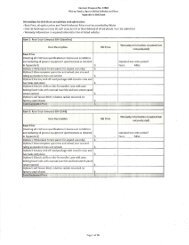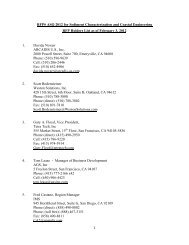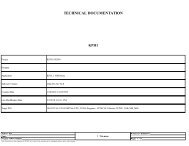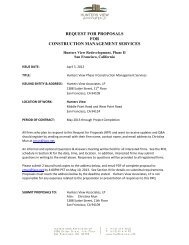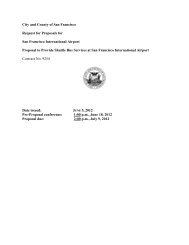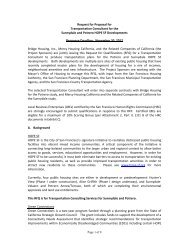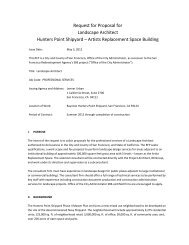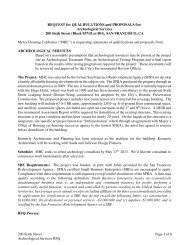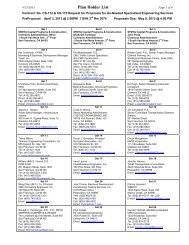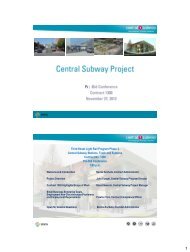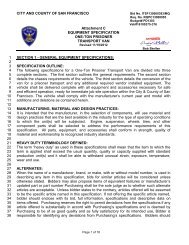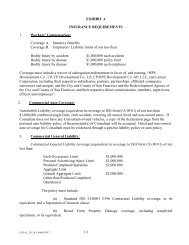Appendix B - Technical Specification--1
Appendix B - Technical Specification--1
Appendix B - Technical Specification--1
Create successful ePaper yourself
Turn your PDF publications into a flip-book with our unique Google optimized e-Paper software.
City and County of San Francisco 79001<br />
San Francisco Public Utilities Commission APPENDIX B<br />
LED LUMINAIRES AND WIRELESS MONITORING AND CONTROL SYSTEM<br />
_____________________________________________________________________________________________<br />
Minimum <strong>Technical</strong> Qualifications<br />
MQ LED Luminaires must:<br />
APPENDIX B - TECHNICAL SPECIFICATIONS<br />
MQ I Must have a LM-79-08 Test Report. Tests must be performed with color temperature of<br />
4500 K or less. Submit one LM-79-08 for each proposed luminaire<br />
MQ J Be UL listed and approved per Standard 1598 (Latest Approved).<br />
MQ K Have an optical assembly protected against dust and moisture intrusion per the<br />
requirements of IP-66 (minimum).<br />
MQ Wireless Monitoring and Control System must:<br />
MQ L Have cell based communication between the communication points and the remote<br />
management server.<br />
1. LED Luminaires should meet the following general requirements:<br />
1.1 Be rated for a minimum operational life of 70,000 hours at an average operating time of<br />
eleven (11) hours per night.<br />
1.2 Have a minimum operational life of seventeen (17) years based on L70 testing. The<br />
illuminance shall not decrease by more than 30 percent over the minimum operational<br />
life.<br />
1.3 Have Correlated color temperature (CCT) of 4,000 Kelvin +/- 300 Kelvin.<br />
1.4 Have NEMA 3-prong twist lock, photo control receptacle in accordance with ANSI<br />
C136.10.<br />
1.5 Contain completely prewired integral drivers and an optical assembly that provide<br />
distribution type II and type III. .<br />
1.6 Emit zero lumens at or above an angle of 90 degrees above nadir.<br />
1.7 Comply with Measurement, Performance and Safety Standards listed below:<br />
1.7.1 ANSI C78.377.2008 - <strong>Specification</strong>s for the Chromaticity of Solid State Lighting<br />
Products.<br />
79001 - <strong>Appendix</strong> B B-1 04/12/11
City and County of San Francisco 79001<br />
San Francisco Public Utilities Commission APPENDIX B<br />
LED LUMINAIRES AND WIRELESS MONITORING AND CONTROL SYSTEM<br />
_____________________________________________________________________________________________<br />
APPENDIX B - TECHNICAL SPECIFICATIONS<br />
1.7.2 IESNA LM-79-08 - IESNA Approved Method: Electrical and Photometric<br />
Measurements of Solid-State Lighting Products.<br />
1.7.3 IESNA LM-80-08 - IESNA Approved Method: Measuring Lumen Maintenance<br />
of LED Lighting Sources.<br />
1.7.4 In-Situ Temperature Measurement Test (ANSI/UL 1598-2004 or ANSI/UL 153-<br />
2005)<br />
1.7.5 IESNA TM-15-07 Luminaire Classification System for Outdoor Luminaires,<br />
Addendum A: Backlight, Uplight, and Glare (BUG) Ratings.<br />
1.7.6 UL Standards (Latest Approved)<br />
• 8750 Light-Emitting Diode (LED) Light Sources for Use in Lighting Products.<br />
• 1012 Power Units Other Than Class 2.<br />
• 1310 Class 2 Power Units.<br />
• 2108 Low Voltage Lighting Systems.<br />
• All components shall be UL listed and approved.<br />
1.7.7 IP-66 or greater Ingress Protection Test Report Certification.<br />
1.8 Warranty<br />
1.8.1 LED Luminaire housing and finish: 10 years.<br />
2. Driver <strong>Specification</strong>s<br />
2.1 All drivers for LED luminaires should be:<br />
• Solid State (Electronic) type<br />
• 0-10V dimming capabilities<br />
• Input voltage from 120-277 VAC (±10%)<br />
• Output voltage of 105-210 VDC (±5%)<br />
• Maximum rated output current of 700 mA (± 5%)<br />
• Input frequency of 50/60 Hz (±5%)<br />
• Line regulation of ±2%<br />
• Output should be isolated<br />
• Power factor 90% or greater at full load<br />
• Total Harmonic Distortion less than 20% at full load<br />
• Load regulation of ±1% from no load to full load<br />
• Case temperature rated for -104°F to +158°F<br />
• Overheat protection<br />
• Self-limited output short circuit protection with automatic recovery<br />
79001 - <strong>Appendix</strong> B B-2 04/12/11
City and County of San Francisco 79001<br />
San Francisco Public Utilities Commission APPENDIX B<br />
LED LUMINAIRES AND WIRELESS MONITORING AND CONTROL SYSTEM<br />
_____________________________________________________________________________________________<br />
2.2 Driver Life<br />
APPENDIX B - TECHNICAL SPECIFICATIONS<br />
• Input overload protection<br />
• Input high voltage surge protection<br />
• Reduce output power and recover automatically if the driver overheats<br />
• Primary fused<br />
• Fully encased and potted<br />
• Meet IP-66 standards<br />
• RoHS compliance<br />
• EMC compliance-FCC 47 part 15B, CISPR 15<br />
• UL listed – UL1310/ UL 48 Class 2 certified<br />
• Class A sound rating per ANSI standard C63.4.<br />
2.2.1 Rated useful lifetime of no less than 100,000 hours at ≤ 65ºC.<br />
3. Luminaire <strong>Technical</strong> Parameters<br />
3.1 Electrical<br />
3.1.1 Operation Voltage<br />
3.1.1.1 Operation from a 60 Hz ±3 Hz AC line over a voltage ranging from 90V<br />
AC to 277V AC.<br />
3.1.1.2 The standard operating voltages are 120V AC and 240V AC. The<br />
fluctuations of line voltage should have no visible effect on the luminous<br />
output.<br />
3.1.1.3 The luminaires should function within an ambient operating temperature<br />
range of -20 °F to +130 °F.<br />
3.1.2 Surge Suppression<br />
The luminaires on-board circuitry should include a surge protection device to<br />
withstand high repetition noise transients as a result of utility line switching,<br />
nearby lightning strikes, and other interference.<br />
3.1.2.1 Protect the luminaires from damage and failure for transient peak voltages<br />
up to 10 kV (minimum) and transient peak currents up to 5 kA<br />
(minimum).<br />
3.1.2.2 Conform to UL 1449, or UL 1283, depending on the components used in<br />
the design.<br />
79001 - <strong>Appendix</strong> B B-3 04/12/11
City and County of San Francisco 79001<br />
San Francisco Public Utilities Commission APPENDIX B<br />
LED LUMINAIRES AND WIRELESS MONITORING AND CONTROL SYSTEM<br />
_____________________________________________________________________________________________<br />
APPENDIX B - TECHNICAL SPECIFICATIONS<br />
3.1.3 Submit chip, diode, or package reliability test report for luminaire.<br />
3.1.4 RF Interference<br />
The luminaires and associated on-board circuitry standard: Class A emission<br />
limits referred in FCC Title 47, Sub Part B, Section 15 regulations concerning the<br />
emission of electronic noise.<br />
3.1.5 Transient Protection<br />
Per IEEE C.62.41-2002, Class A operation. The line transient should consist of<br />
five strikes of a 100k Hz ring wave, 2.5 kV level, for both common mode and<br />
differential mode.<br />
3.1.6 Frequency<br />
Output operating frequency: ≥ 120 Hz (to avoid visible flicker) and input<br />
operating frequency of 60 Hz.<br />
3.1.7 LED Luminaires Efficacy and Efficiency<br />
A minimum efficacy of 57 lumens per watts lm/W) or better is desired. Allowing<br />
for thermal and optical losses, efficiency should be determined on a delivered<br />
lumens per watt basis for comparison at drivers that are 550 mA and less.<br />
3.2 Thermal Management<br />
3.2.1 Maximum junction temperature < 105 °C.<br />
3.2.2 The LED manufacturer’s maximum junction temperature for the expected life<br />
should not be exceeded.<br />
3.3.3 Passive by design heat sink with no fans, pumps, or liquids.<br />
3.4 Physical and Mechanical <strong>Specification</strong>s<br />
3.4.1 Luminaire maximum weight: 35 pounds.<br />
3.4.2 The luminaire width maximum width: 16” wide.<br />
3.4.3 The housing should include a down opening door or doors for access to all<br />
internal components. The housing should be a light or medium gray color with a<br />
flat or semi-gloss sheen and rust resistant paint that is corrosion resistant and<br />
tested to withstand a minimum 3,000 hours in salt and fog condition as defined in<br />
ASTM Standard B117.<br />
3.4.4 Stainless steel screws.<br />
79001 - <strong>Appendix</strong> B B-4 04/12/11
City and County of San Francisco 79001<br />
San Francisco Public Utilities Commission APPENDIX B<br />
LED LUMINAIRES AND WIRELESS MONITORING AND CONTROL SYSTEM<br />
_____________________________________________________________________________________________<br />
APPENDIX B - TECHNICAL SPECIFICATIONS<br />
3.4.5 No polycarbonate parts unless it is UV stabilized (lens discoloration will be<br />
considered a failure under warranty).<br />
3.4.6 Each housing should be provided with a slip-fitter capable of mounting on a<br />
minimum 2.25 to 2.50-inch O.D. pipe tenon.<br />
3.4.6.1 The slip-fitter should be capable of being adjusted a minimum of ±5 degrees<br />
from the axis of the tenon in a minimum of five steps (+5, +2.5, 0, -2.5, -5).<br />
3.4.6.2 The clamping brackets of the slip-fitter should not bottom out on the<br />
housing bosses when adjusted within the designed angular range.<br />
3.4.7 The luminaires should meet 3G Vibration Test per ANSI C136.31-2001<br />
requirements.<br />
3.4.8 Hinged access doors, capable of opening to 180 degrees are desired. The door<br />
should be secured to the luminaires housing.<br />
3.4.0 Field wires connected to the luminaires shall terminate on a barrier type terminal<br />
block secured to the housing. The terminal screws shall be captive and equipped<br />
with wire grips for conductors up to No. 6. Each terminal position shall be clearly<br />
identified.<br />
3.5 Housing Materials<br />
3.5.1 Die cast aluminum that is heavy duty and structurally rigid.<br />
3.5.2 Housing should be fabricated from materials that are designed to withstand a<br />
3000-hour salt spray test as specified in ASTM Designation: B117.<br />
3.5.3 Each refractor or lens should be made from UV inhibited high-impact plastic such<br />
as acrylic or polycarbonate.<br />
3.5.4 Polymeric materials (if used) of enclosures containing either the power supply or<br />
electronic components of the luminaires shall be made of UL94VO flame<br />
retardant materials. The lenses of the luminaires are excluded from this<br />
requirement.<br />
3.6 Luminaires Identification and Inventory<br />
Each luminaires shall have a barcode permanently and securely stuck in the housing and<br />
on the corresponding packaging box. The barcode when read should contain the model<br />
79001 - <strong>Appendix</strong> B B-5 04/12/11
City and County of San Francisco 79001<br />
San Francisco Public Utilities Commission APPENDIX B<br />
LED LUMINAIRES AND WIRELESS MONITORING AND CONTROL SYSTEM<br />
_____________________________________________________________________________________________<br />
APPENDIX B - TECHNICAL SPECIFICATIONS<br />
number, and serial number. In addition to the bar code, there shall be a label that includes<br />
date of manufacture (month and year) and drive current.<br />
3.6.1 Bar code language shall be Code 128.<br />
3.7 Wireless Monitoring and Control System<br />
3.7.1 General System Parameters<br />
3.7.1.1 Remote, secure desktop monitoring and control of the either individual or<br />
groups of luminaires from a secure website.<br />
3.7.1.2 Automated detection and reporting of cycling lamps, fault conditions,<br />
malfunctioning equipment, voltage, current, power factor, and energy<br />
consumption.<br />
3.7.1.3 Capture, record and report historical data for items listed in 3.7.1.2.<br />
3.7.1.4 System hardware shall form a wireless, self-healing, mesh, and/or point to<br />
multipoint network.<br />
3.7.1.5 Compatible with solid state and HID lighting<br />
3.7.1.6 Provide dimmable control of LED luminaires in selectable increments of<br />
10% between 0-100%.<br />
3.7.1.7 Capable of expansion.<br />
3.7.1.8 A built-in backup clock to control switching in case of a failure of the<br />
main server, or a break in communication between the luminaire and the<br />
main server is desired.<br />
3.7.1.9 Wireless communication to use frequencies and implement algorithms<br />
that minimizes the degradation of communication due to losses, such as<br />
ambient noise for other wireless communication devices.<br />
3.7.1.10 A metering chip that records energy consumption at the LED luminiare<br />
that can be retrieved to generate billing reports is desired. The metering<br />
chip should meet the California Public Utilities Commission (CPUC) ±<br />
2% accuracy requirement in both steady-state and dimmed modes.<br />
3.7.1.11All components should be UL listed and approved<br />
79001 - <strong>Appendix</strong> B B-6 04/12/11
City and County of San Francisco 79001<br />
San Francisco Public Utilities Commission APPENDIX B<br />
LED LUMINAIRES AND WIRELESS MONITORING AND CONTROL SYSTEM<br />
_____________________________________________________________________________________________<br />
APPENDIX B - TECHNICAL SPECIFICATIONS<br />
3.7.2 Wireless Monitoring and Control System Luminaire Controllers<br />
3.7.2.1 Luminaire Controllers specifications:<br />
• Wireless communication range: a minimum of 400 linear feet.<br />
• Encryption standard: AES algorithm128 bit encryption.<br />
• NEMA 3-prong twist lock compatibility.<br />
• Operational between 120V to 277V power.<br />
• Maximum average power consumption: 3 watts.<br />
• ANSI C136.10-2006 compliant.<br />
• In the event of a network failure, the luminaire controllers should fail to<br />
‘on’ condition, and default to an internal clock with scheduling<br />
capacity.<br />
• Antenna housing shall be grey.<br />
3.7.2.2 Communication Points specifications:<br />
• Communication to remote server encryption using Secure Sockets<br />
Layer (SSL) protocol or equal.<br />
• Must control a minimum of 150 luminaire controllers.<br />
• Mounting on a street light mast arm or pole.<br />
• 320J MOV - 6,500 amp surge protection.<br />
• IP66 or greater.<br />
• Maximum weight: 12 lbs.<br />
3.7.3 System Monitoring and Control Web Portal<br />
3.7.3.1 Should provide system operators the capability to wirelessly monitor and<br />
control the lighting system assets from a web portal that is customizable<br />
per the SFPUC requirements.<br />
3.7.3.2 System capabilities:<br />
• Interactive maps that provide a geographical representation of street<br />
lights.<br />
• System summary/dashboard.<br />
• Ability to control individual or groups of luminaires.<br />
4.0 Glossary<br />
Wherever the following terms or abbreviations are used, the intent and meaning shall be<br />
interpreted as follows:<br />
AC Alternating current<br />
ANSI American National Standards Institute<br />
ASTM American Society for Testing and Materials<br />
79001 - <strong>Appendix</strong> B B-7 04/12/11
City and County of San Francisco 79001<br />
San Francisco Public Utilities Commission APPENDIX B<br />
LED LUMINAIRES AND WIRELESS MONITORING AND CONTROL SYSTEM<br />
_____________________________________________________________________________________________<br />
APPENDIX B - TECHNICAL SPECIFICATIONS<br />
AWG American Wire Gauge<br />
BUG “Backlight”, “Uplight”, “Glare”. Describes the types of stray light escaping<br />
from an outdoor lighting luminaires. “B” refers to backlight, or the light<br />
directed in back of the mounting pole. “U” refers to uplight, or the light<br />
directed above the horizontal plane of the luminaire, and “G” refers to glare,<br />
or the amount of light emitted from the luminaire at angles known to cause<br />
glare.”<br />
CCT Correlated Color Temperature. A visible light characteristic of comparing a<br />
light source to a theoretical heated black body radiator. Measured in degrees<br />
Kelvin. The absolute temperature of a blackbody whose chromacity most<br />
nearly resembles that of the light source.<br />
Cd Candela. Unit of measurement of luminous intensity.<br />
Chromacity The property of color of light.<br />
CRI Color Rendition Index<br />
°C Degree Celsius<br />
DC Direct Current<br />
°F Degree Farenheit<br />
Fc Foot-candle. A unit of illuminance equal to lumen per square feet or 10.76<br />
lux.<br />
FCC Federal Communications Commission<br />
Hz Hertz<br />
IESNA Illuminating Engineering Society of North America<br />
IP-66 International Protection rating, sometimes referred to as Ingress Protection,<br />
that delineates the level at which foreign objects and water can intrude inside<br />
a device.<br />
IEEE Institute of Electrical and Electronics Engineers<br />
ITL Independent Testing Laboratories, Inc.<br />
KA Kilo-Ampere<br />
KV Kilo-Volt<br />
KWH Kilo-Watt Hour<br />
LED Light-Emitting Diode<br />
LLF Light Loss Factor<br />
L70 Time of operation (in hours) to 30% lumen depreciation (i.e. 70% lumen<br />
maintenance), derived from Luminaires in-situ temperature measurement<br />
testing (i.e. LED chip package temperature (TS) measurement obtained with<br />
the LED chip package operating in given luminaire and in a given stabilized<br />
ambient environment) under UL 1598 environments and directly correlated<br />
to LED package manufacturers IESNA LM-80-08 data<br />
LM-79-08 IES Approved Method for the Electrical and Photometric Measurements of<br />
Solid-State Lighting Products, developed by a joint IES-ANSI.<br />
LM-80-08 IES Approved Method for Measuring Lumen Maintenance of LED Light<br />
Sources.<br />
79001 - <strong>Appendix</strong> B B-8 04/12/11
City and County of San Francisco 79001<br />
San Francisco Public Utilities Commission APPENDIX B<br />
LED LUMINAIRES AND WIRELESS MONITORING AND CONTROL SYSTEM<br />
_____________________________________________________________________________________________<br />
APPENDIX B - TECHNICAL SPECIFICATIONS<br />
LM/W Lumens per watt<br />
mA Milliamps<br />
METS Material Engineering and Testing Services of the Translab<br />
NEMA National Electrical Manufacturing Association<br />
NEC National Electrical Code<br />
NVLAP National Voluntary Laboratory Accreditation Program. A program under the<br />
US DOE to accredit independent testing laboratories to qualify.<br />
O.D. Outside Diameter<br />
Power factor The ratio of the real power component to the total (complex) power<br />
component.<br />
QA Quality Assurance<br />
Rated power The power consumption that the luminaire was designed and tested for at<br />
ambient temperature (70° or 21°C). See Design Qualification Testing.<br />
RoHS Restriction of Hazardous Substances<br />
SPD Surge Protection Device. A subsystem or component(s) that can protect the<br />
unit against short duration voltage and current surges.<br />
SFPUC San Francisco Public Utilities Commission<br />
THD Total Harmonic Distortion. The amount of higher frequency power on the<br />
power line.<br />
UL Underwriters Laboratories<br />
UV Ultraviolet<br />
V Volts<br />
W Watts<br />
END of SECTION<br />
79001 - <strong>Appendix</strong> B B-9 04/12/11



